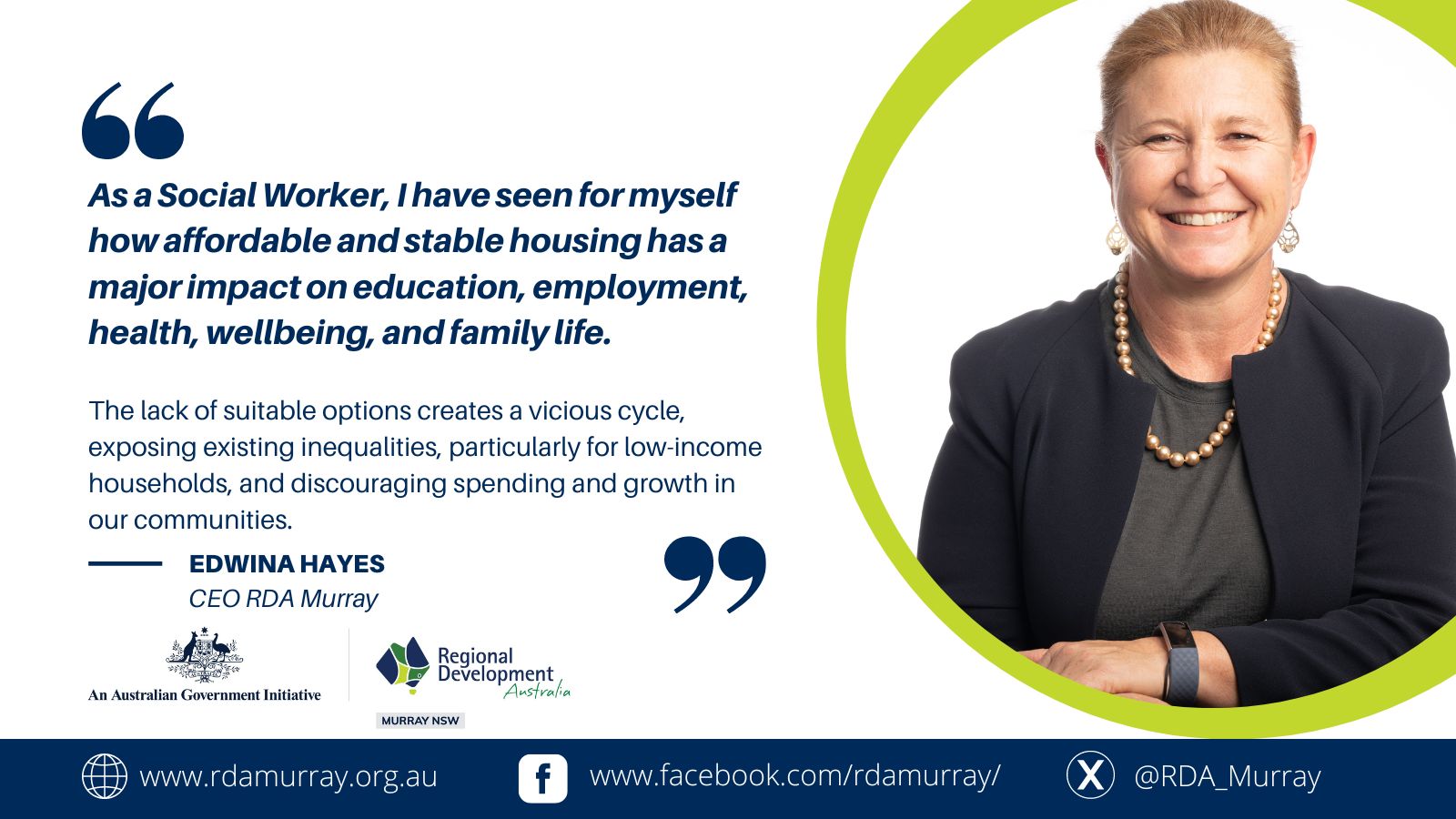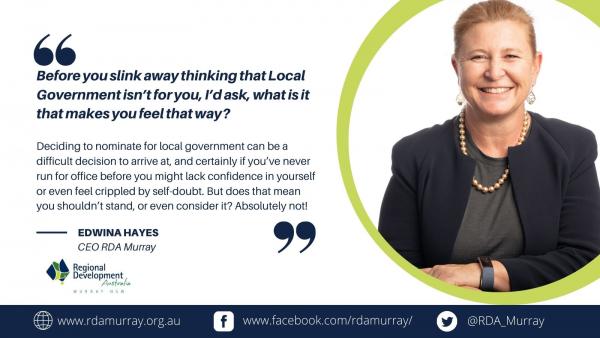Of all the goods and services that we buy in our lives, it is hard to think of one that is more important than housing. Where we live has a major influence on our day-to-day lives, governing how much time we spend travelling to work, school, and other commitments, as well as to visit family and friends. Regardless of whether we buy or rent our home, housing will account for a large amount of our spending over our lifetimes.
It is my firm belief that everyone deserves a safe, stable, and affordable place to call home. And considering the importance of housing, it’s no surprise that this issue is under the spotlight in Australia. Across the country people are struggling to find suitable housing, especially rentals. And writing this blog has made me reflect on the special challenges faced in rural and remote parts of the country. The further you are away from a city centre the more profound the impact of accommodation stress is and in some isolated areas the cost of building is more than the sale price of the finished property! Smaller local government planning teams are impacted exponentially by vacancies, and getting busy tradies lined up in a cost and time effective project building timeline, or even just to repair and maintain rural properties, can be extremely challenging. In many areas demand for properties, and tradespeople, is outstripping supply, creating a major barrier to growth, and the potential impact on our local economies is simply too great to ignore.
For at least the next couple of decades the Murray region will be markedly impacted by a number of major National infrastructure projects that could bring increased people, skills, and employment to our region. These workers will spend their wages at our restaurants, retail stores and services which could help to create new jobs at these businesses. It should be a win-win situation, and yet in some of our communities it’s almost impossible to find a property to rent or buy, so where will all these new people live?
With billions of dollars in infrastructure development on the horizon, we need to address the demand for housing, with a range of suitable homes and accommodation, to keep the project on track, keep up with our growth and help our communities feel the full benefits of these projects.
Even without these major projects, the lack of suitable or affordable housing can make it harder for our employers to attract and retain staff, effectively slamming the brakes on economic growth and business productivity. However, it’s not just about businesses and attracting new residents, this situation has a huge impact on local people too. A scarcity of available homes means a likely shortage of affordable residences, social housing, and crisis accommodation, increasing the odds of local people being trapped in dangerous situations or unsuitable housing. And if residents can’t find a home that meets their needs in our area, they may have to move somewhere else, taking their skills and families with them.
As a Social Worker, I have seen for myself how affordable and stable housing has a major impact on education, employment, health, wellbeing, and family life. The lack of suitable options creates a vicious cycle, exposing existing inequalities, particularly for low-income households, and discouraging spending and growth in our communities.
At its core, this is a multilayered issue and one that affects different groups of people in different ways. Certainly, renters, home buyers, and low-income families are among those most affected by the shortage, but across the board there is a perfect storm of staff shortages, escalating material and labour costs and the entire sector is in a state of flux. From landowners, developers, planners, construction and building personnel to homeowners, landlord investors and renters, everyone is affected by a moving feast of job vacancies and supply chain uncertainty.
What is glaringly obvious is that we can’t do what we’ve always done and expect a different result. Meaning this is an opportunity to explore new ideas, see what is broken, sort out what can be fixed and what can be used in the interim until we can find better solutions for the short, medium, and longer term. So, what might some potential solutions be?
Share accommodation: At a time where renting is more unaffordable than ever, more and more people are turning to sites like Flatmates.com.au to find affordable and convenient housing options. Increasingly a popular option for students, young professionals, migrants and even those just looking for cheaper living arrangements, shared accommodation offers many benefits, including cost-effectiveness, friendship, shared responsibilities and resources, and a sense of security.
Granny flats: Many homes in our region have the potential to host a granny flat. Adding a granny flat offers extra, independent living space for family, friends, or rental purposes. A home built on the property of a friend or family member can provide a vital lifeline, especially to older women who are now the fastest growing group of people facing housing stress and homelessness in Australia. In NSW, granny flats or similar dwellings that meet set criteria can now be approved without the need for lengthy, traditional council development approval. As well as potentially offering a home for friends or family, the addition of a secondary dwelling on your property could provide income for those who choose to rent it out and could even increase your overall property value.
Employer assisted housing: We have heard from local employers that prospective employees have had to turn down jobs because they can’t find a place to live in the area. With the housing shortage making it more difficult to recruit and retain staff, some businesses might find it necessary to invest in staff accommodation. Whilst obviously not an option for every employer, for employers feeling the strain of a tight recruitment market, subsidised housing could be an interesting option to attract employees, supporting employers to achieve their business goals while helping employees meet their housing needs.
Infill in CBDs: Is it time for the old concept of ‘living above the shop’ to make a comeback? Many people desire the fast paced, convenience of living where the action is at. An increase in mixed use zoning, such as offering empty residential units above commercial premises for rent, would allow us to squeeze more value out available land and existing structures. For some people, especially the young or busy professionals, living in the CBD with easy access to work, bars, cafes, and restaurants is bound to be attractive. I love the idea of natty business landlords converting office space no longer required because people are working from home more into modern accommodation.
Transportable or modular homes: In December 2023 a self-contained workers camp of transportable, modular facilities including bedrooms, ensuites and bathrooms, kitchens and dining rooms, gyms, wifi, offices and storage areas opened at Lockhart as part of EnergyConnect project. Home to 200 workers the camp is a part of a six-camp system housing 1,387 beds across the region. The camp allows the project to bring workers into local communities, easing pressure on the local rental market and accommodation providers and not taking up housing local families may need. Low-cost modular facilities such as these, that can be erected and removed quickly, have already been used in flood and fire events, or as quarantine accommodation during the initial COVID outbreak and if utilised on a wider scale could be modified to create tiny homes to ease some of the immediate impacts of the housing shortage. Indeed, trials are already underway in some areas and the NSW government is investigating whether modular housing could provide dwellings for the more than 57,000 people on the social housing wait list.
Rent out your rooms: The latest Census, found there are more than 12 million spare bedrooms in Australia. Renting out your spare room to a lodger could provide valuable extra income to offset your mortgage, assist with the cost-of-living and help you build up your savings. You could be contributing to your local community and economy providing a home for desperately needed new child carers, nursing and teaching staff or engineers and tradies who will kick start a cycle of building more accommodation and providing extra care and training for newcomers to work in other fields. Increasing supply in the tight rental market will help people live closer to where they work, as well as offering companionship and help with jobs around the house for people rattling around in 3- and 4-bedroom homes.
Holiday houses and Airbnb’s: The NSW government has found there are as many as 90,000 houses, including holiday homes, short-term rentals, and vacant properties, that if offered for long term rent, could help reduce the housing crisis. This comes as the West Australian government are offering short-term accommodation owners a $10,000 incentive to boost housing supply by renting their properties to long-term tenants. In the face of rising costs, some property owners are already leaving the short-term accommodation market in favour of long-term renting and the increased certainty it offers. If more owners were to consider a move to long-term rentals, this could provide a massive boost to certainty in the housing supply.
Cooperative housing: Cooperative housing, where residents collectively own and manage properties, is on the rise in Australia with more than 8000 people embracing this option. Already a popular model in other parts of the world, cooperative housing offers affordable, secure rental housing where residents share responsibilities like maintenance, repairs, and decision-making, removing the need for a landlord. As housing co-ops are managed by their members, they are usually better maintained than other rental homes, as well as having better security and lower crime rates. Because they have greater control and security, this form of housing also creates a stable community and a strong sense of pride among residents who tend to stay long-term. You can find out more about housing cooperatives in NSW here: https://www.commonequity.com.au/
I’m positive that there are those among you who will have other (potentially better!) ideas about how to ease the housing stress currently being experienced by so many. If you do, I’d love to hear your suggestions! As far as I can see, we need practical solutions that could be put into action reasonably quickly as well as the collective will to do something. But this is a complex problem and one that has been developing over many years. As such, there is no single solution to the housing affordability crisis. Addressing it will require a comprehensive, all-in approach from government, policymakers, developers, nonprofits, philanthropies, businesses, landlords, and community members. If ever there was an opportunity to pull together and make a profound difference for the sake of our communities, it is now.




